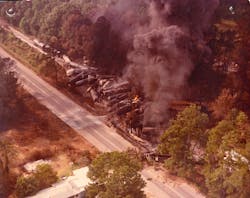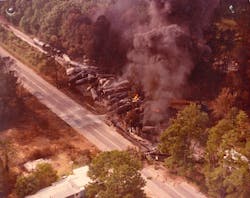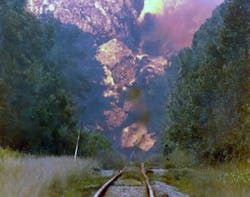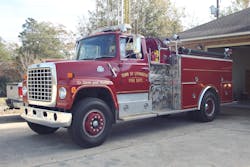Hazmat Studies: Livingston, LA, Train Derailment—36 Years Later
Sept. 28, 1982, began like no other in Livingston, LA. Shortly after 5 a.m., 36 cars of a 101-car Illinois Central Gulf (ICG) train derailed in the center of this small community, located 50 miles east of the state capitol of Baton Rouge.
A history of derailments
Derailments were nothing new to this stretch of ICG Railroad tracks built in 1908 from Baton Rouge to Hammond. Previous derailments had occurred involving grain that was shipped from Illinois to Baton Rouge for river shipment to New Orleans and beyond. Near Holden, the first shipment of grain in the late-1960s saw the derailment of nine grain cars. During the same trip, another derailment occurred in Baton Rouge Parish, where 14 cars left the track when it collapsed under the weight of the grain cars. That same year, 13 cars and chemical tankers derailed near Albany. In another incident, seven cars derailed outside the corporate limits of Denham Springs. This time a bridge over Gray’s Creek collapsed.
Over the next several years, additional derailments occurred on the troubled stretch of track. Fifty families in Corbin, a small community near Walker, were evacuated in 1970 after a tank car of petroleum and another containing vinyl chloride derailed. A year later, 300 families were evacuated in the same community because of a derailment that occurred after vandals broke a lock on a switch box and opened it, causing the train to go onto a spur line. A car of vinyl chloride left the tracks, ruptured and caught fire. In the same year, another grain train derailed, causing 11 cars to leave the tracks near Amite. In 1978, 10 cars derailed when the tracks collapsed near Walker. And in 1980, more than 2,500 residents of Hammond, including Southeastern Louisiana University students, were evacuated when a train derailed, spilling styrene monomer chemicals. That same year, a derailment resulted in a train coming to rest within 15 feet of an elementary school. Fortunately, it was Saturday so school was not in session.
Livingston incident
In the 1982 derailment, 36 cars derailed near the fire department and high school, both located in the center of Livingston, population around 1,000. Of the 36 derailed tank cars, 27 contained various regulated hazardous or toxic chemical commodities, two contained non-regulated hazardous materials, and five contained flammable petroleum products. A total of 20 tank cars were punctured or breached in the derailment.
Chemicals released included glycol, hydrofluosilicic acid, phosphorus, methyl chloride, sodium metal, tetraethyl lead, toluene, diisocyanate, perchloroethylene, styrene, vinyl chloride, fuel oil, lube oil and polyethylene. In addition to the spills, smoke and toxic materials were released into the air.
Explosions and fires occurred almost immediately. Emergency responders did not need to be called, however, the Livingston volunteer firefighters could only watch from a safe distance, as there was nothing they could do at that point.
Everyone in town heard the noise and saw the sky light up from the fires. Hannon Stewart, who owned Livingston’s ambulance company, lived about 150 yards from the railroad. He thought it was the end of the world. His fleet of ambulances was damaged beyond use. Had he been able to use one of them, the only road from his house was blocked by the derailment. Fortunately, there was no immediate need for the ambulances.
Residents in Denham Springs and Springfield heard the initial blasts when the train derailed. Livingston Mayor Allen Hunt and Fire Chief Darrel Jones decided everyone should withdraw to a safe distance.
Police cars with loud speakers went through the city notifying residents to evacuate immediately. The people left so fast that many failed to take extra clothing, pets, food, medicine and other personnel property. The initial evacuation distance was one mile in all directions and was later extended. The evacuations went smoothly, with 3,000-plus people being evacuated in a 5-mile radius of the derailment, some for two weeks. Most evacuations were completed in two hours. Those who did not have any place to go were housed in the Walker High School gym.
Experts arrived quickly and Chief Jones reported that CHEMTREC—a public service hotline for emergency responders needing hazmat response coordination—was very helpful at the beginning of the incident. Fires were mostly allowed to burn rather than be extinguished, but firefighters stood by ready to fight fire if needed, and they responded to structure fires caused by explosions during the derailment.
The Railroad EPA Region 6 on-scene coordinator was Frank Gordy. The Coast Guard Gulf Strike Team responded as well. Louisiana State University sent a foam truck with a monitor to fight flammable liquid fires.
In Louisiana, the state police provide response stabilization for hazmat incidents. The police sent the State Hazardous Waste Team, which brought equipment and supplies, and explosives experts from the state police were also dispatched. A state police helicopter was dispatched for aerial surveillance of the scene. Video and still photographs were returned to the command post and studied for information on the tanks and status of the fires.
Making progress
By nightfall on the first day, environmental officials knew three-fourths of the overturned tank cars contained toxic chemicals. Managers from companies responsible for the chemicals, hazardous waste response personnel, and railroad officials met to discuss the action plan.
The original command post was determined to be too close and was moved 2 miles away, near Interstate 12. A forward command post was retained where decontamination took place. All water from decontamination was collected and properly disposed of as hazardous waste. Twenty-four-hour air monitoring was conducted by the Louisiana Department of Environmental Quality (DEQ). They also tested soil and ground water for contamination.
By day three, initial fires had subsided to small, lazy fires, and the identification of the locations of tank cars began along with damage assessments by engineers. The sodium metal car was found to be intact. The railroad began cleanup with vacuum trucks for chemicals that had spilled. They were hauled to a hazardous materials waste site. All personnel conducting the clean-up operations wore appropriate chemical protective clothing.
On day four, there were not many tasks to be accomplished at the derailment site, so personnel addressed other needs, such as feeding pets and livestock that were not evacuated, and contamination tests on water and vegetation. Contaminated water was being hauled to a disposal company, and police officers continued their security patrols.
Plans were made to start extinguishing small fires in and around the derailed tank cars. At approximately 3:15 p.m., a spectacular explosion occurred, causing a massive fireball of 400 feet in height and a mushroom cloud visible 15 miles away. The tank car of tetraethyl lead had been weakened by the flame impingement, causing a boiler-type explosion, and the main part of the tank rocketed 600 feet. It caused damage a half-mile away. The tank car struck a mobile home, causing it to catch fire. It burned to the ground before firefighters could extinguish the fire. ICG sent a response team following the explosion.
By day seven, fires once again began to subside, and the process of clearing debris and contamination resumed. During the clearing process, a tank car of styrene ignited and burned. CHEMTREC provided a conference call between the officials in Livingston and the three top manufacturers of the product in the United States.
Now all that remained were the six tank cars of vinyl chloride. Experts determined that it was too dangerous to try to move or offload the derailed tanks. They decided to blow them up and burn off the product, a process known as vent and burn. A pit was dug around the cars to contain the vinyl chloride spilling from the breached tank, and allow the vinyl chloride to burn. It took 12 hours to burn the contents of the six cars.
During the sixth day of the incident, the controlled explosions were set off at 5:30 p.m. Fires burned through the night, making it easier for railroad workers to remove cars.
State Health Department personnel used data from monitoring and testing to make the decision to allow residents to return. Finally, residents were allowed to return to their homes, offices and businesses, and begin to decontaminate.
Assessing the damage
Stewart lost his home and other buildings on the property. His home was torn down after the railroad purchased the property. He did not replace his ambulances and retired.
Nineteen homes and other buildings in Livingston were destroyed or severely damaged. Rail lines and the adjacent highway were closed for an extensive period of time. Damage from the derailment cost in excess of $14 million.
Environmental cleanup took several months. Over 200,000 gallons of toxic chemical products were spilled and absorbed into the soil, requiring extensive remediation that involved removing soil 50 feet deep and replacing it with uncontaminated soil. The contaminated soil had to be transported to a remote dump site miles away.
Because of residents’ exposures to toxic chemicals prior to and during the evacuation, a clinic was established by the railroad in Livingston to test victims for the next 30 years. Monitoring wells were installed to check for subsurface contamination and remained in place until 2016.
Investigation and changes
The National Transportation Safety Board (NTSB) conducted an investigation and issued a report in 1983. It determined that several factors contributed to the derailment:
- Disengagement of a worn air hose coupling as the train passed over a low track joint, which initiated an automatic emergency application of the train’s brakes.
- An excessive buff force within the train resulted in the failure of the person at the locomotive controls to respond to the brake application.
- Placement of empty cars near the front of the train between heavily loaded cars.
- Impairment of the engineer’s faculties by alcohol and abandonment of locomotive control to an unauthorized and unqualified person.
- Failure of the ICG to supervise train operations and personnel adequately, and a lack of inspection and maintenance of the Hammond District main track.
- Environmental damage was impacted by a lack of shelf couplers on some tank cars and inadequate protection of bottom outlets on the bottom of some cars.
During my visit to Livingston, I learned from local officials that the train engineer had permitted a female friend to ride on the train and placed the unqualified person at the train’s controls. It was also reported that both may have been under the influence of drugs and or alcohol at the time.
Following the Livingston derailment, railroad officials elected to install heavier rails and reconstructed the road bed, hoping it would stop future derailments. In 1982, the Livingston derailment was considered the granddaddy of all train wrecks. Since then, there have been no reported derailments along the 50-mile stretch from Hammond to Baton Rouge. Constant inspection and prompt maintenance seem to have put an end to the issue. Trains still carry hazardous materials, but also seem to travel at safer speeds.
The Livingston Incident was the worst in Louisiana history, but was also the best handled, as there were no serious injuries or death during the immediate response. During cleanup, a railroad worker lost both legs when a cable broke during clearing operations. Additionally, the first three state troopers to arrive on the site have since died from cancer. It is unknown how many others may have died from cancer caused by exposure to toxic materials during the incident.
Livingston today
Livingston still has a volunteer fire department with one paid driver during the day and all volunteer at night. Engine 1 is the only remaining apparatus from the 1982 derailment. The city has rebuilt many areas damaged by the derailment, but the area in front of the fire station on Highway 190 is now a park. Only a concrete slab remains from a dentist’s office that was destroyed in the derailment. Hazmat response is still handled by the Louisiana State Police. The rail line is now owned by the Canadian National (CN) Railroad. Hazardous materials are still shipped regularly through Livingston.
For additional information, contact Livingston Fire Department Fire Chief Kirk B. Duffy at (225) 445-6332 or Livingston May David McCreary at (225) 445-686-7153.
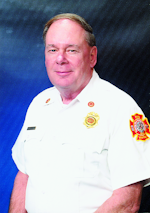
Robert Burke
Robert Burke, who is a hazardous materials and fire protection consultant and who served as a Firehouse contributing editor, is a Certified Fire Protection Specialist (CFSP), Fire Inspector II, Fire Inspector III, Fire Investigator and Hazardous Materials Specialist. He has served on state and county hazmat teams. Burke is the author of the textbooks "Hazardous Materials Chemistry for Emergency Responders," "Counter-Terrorism for Emergency Responders," "Fire Protection: Systems and Response," "Hazmat Teams Across America" and "Hazmatology: The Science of Hazardous Materials."
